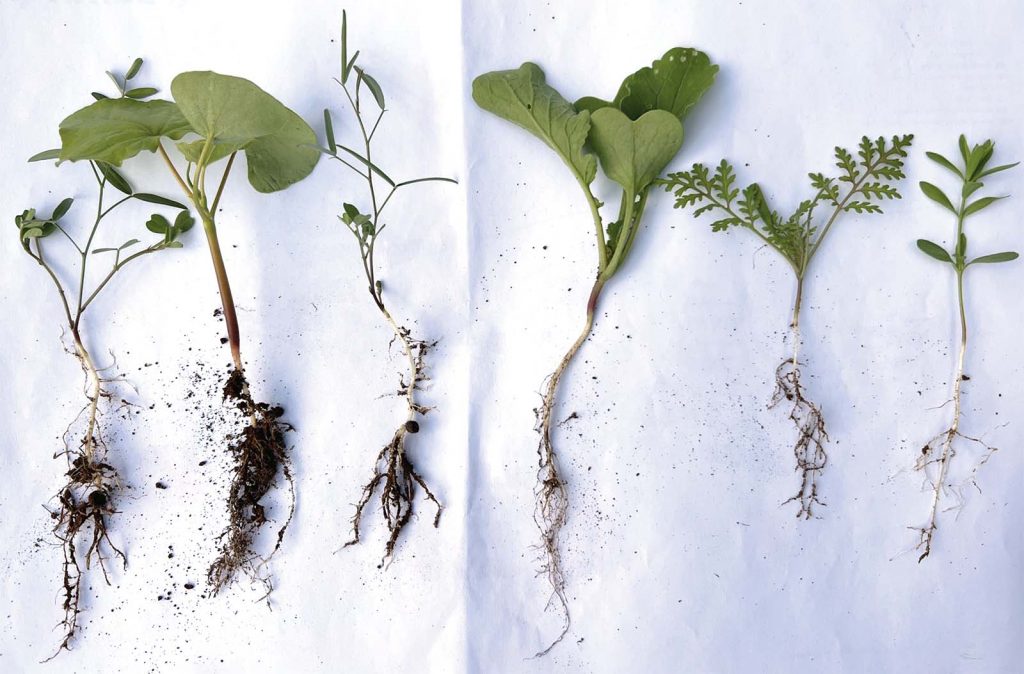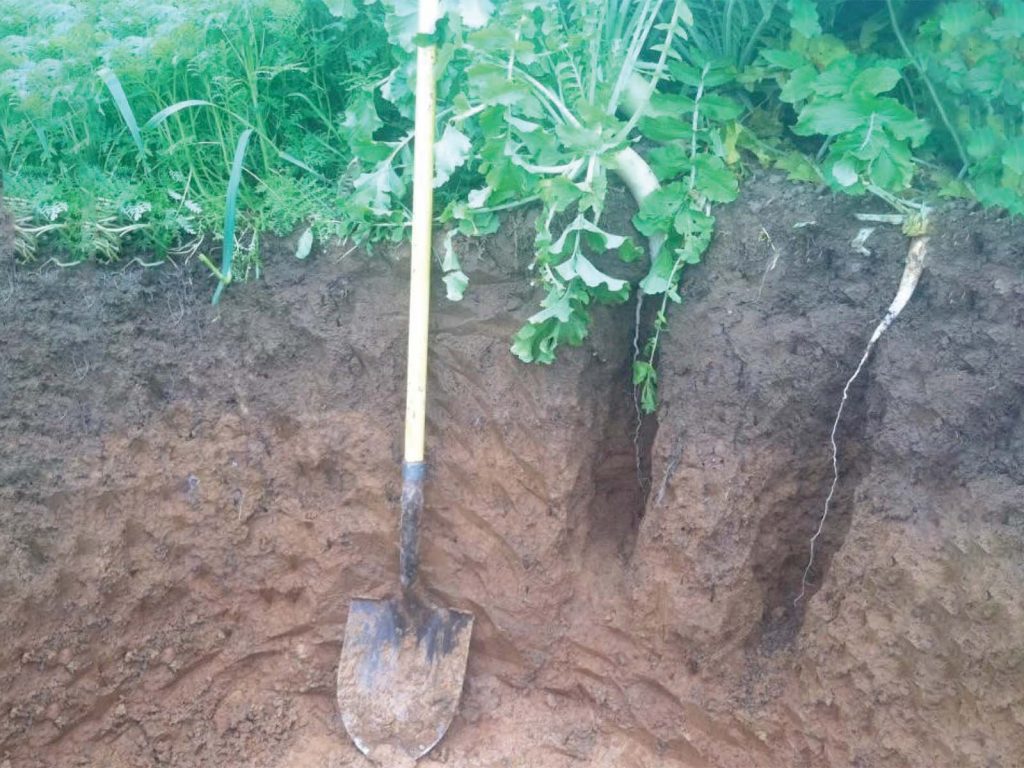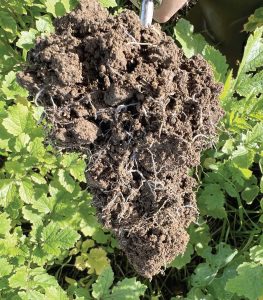Download pdf: Impact of Catch and Cover Cropping on Potassium Cycling (5.42M)
pdf 5.42M
Impact of Catch and Cover Cropping on Potassium Cycling
July 2023
Cover and catch cropping form an important cog in the arable regenerative farming wheel, helping to provide soil cover at times when no plants would otherwise be growing, and providing the living roots after harvest to help feed bacteria and fungi that form part of the food web and maintain soils in a healthy state.

These plants, like all plants, will access nutrients from the soil, which hopefully then contribute to the needs of the following crops rather than some having been lost through leaching. One of the many challenges, however, is that there is no specific definition of a cover crop, it all depends on what species are grown, when they are drilled, how well they are established and how successfully they establish and grow, which means that there is no ‘standard’ data available on what a ‘cover crop’ will deliver, nor when the nutrients in its biomass will become available to subsequent crops.
Especially for nitrogen, including where legume species are grown to fix nitrogen during the cover crop growth period (if long enough to nodulate and begin the fixation processes), the theory of utilising catch or cover crops for nutrient cycling would seem sensible. Plants growing at a time of the year when nothing would otherwise be growing will pick up nutrients from the soil. These nutrients, particularly the more mobile ones, such as nitrogen and sulphur, as well as potassium on light soils, may otherwise be at risk of moving down the profile following rainfall (particularly in late autumn or over winter). If they are ‘held’ within the cover crop, they are protected in the topsoil, to be released back to the soil at some point following termination (whether by frost, physical or chemical means). To a large extent, this is what the previously harvested crop has already achieved, with nutrients ‘held’ within the straw (where it is not removed) and the decaying root systems.
Not all nutrients behave the same way, with most being held within the structural parts of the plants; these will only become available (or at risk of leaching) once the plant begins to breakdown or decompose. Potassium is atypical, in that it is found in plants as the free K+ ion, or held in weak complexes, meaning it is released much more quickly and easily from unharvested material and residue. The rate of release is largely related to rainfall amounts and timing.
Figure 1 (below) shows the range in plant species used in the UK and the frequency of their use on different soil types.
(Source: Storr, Simmons and Hannam, 2018)
In terms of their impact on the cycling of potassium in particular, species that pick up the available potassium in the soil and release it after destruction will have limited benefit other than on very light soils, where the potassium may otherwise move down the soil profile, although this requires significant rainfall.
However, with the majority of nutrients likely to be slowly released from the unharvested material of the previous crop, this leaves the remaining available nutrients in soil as a target for catch or cover crops to take up.
Most catch and cover crops carry out the same functions as many cash crops, the only difference being that they have a shorter growing period and are generally not harvested. These plants will therefore be utilising the same available (or exchangeable) nutrients within the soil, meaning the potential for plants to cycle nutrients will depend on the levels within the soil. Cover or catch crops grown on soils with low available potassium are likely to contain less potassium than plants grown on a soil with a higher level of available potassium, just as would be the case for any cash crops.

Photo courtesy Natalie Lounsbury, University of Maryland.
There are a number of variables surrounding how much nutrient catch and cover crops may pick up and release back to the following crop, and species and soil nutrient levels are two of them. Another is the length of time these crops are growing, as this will impact their access to soil reserves, effectively through the size and architecture of their root systems.
From a potassium perspective, the most effective plants at providing a benefit for following crops will be those that are able to access potassium reserves from deeper soil layers, bringing it closer to the surface, such as fodder radish (see picture). This is less likely when these species are grown as cover or catch crops as the growing period is short and therefore roots are unlikely to have had time to develop fully before they are stalled by the weather, or destroyed for the establishment of the following cash crop.
Once a cover crop is terminated, the nutrients contained in the residue will become available to the following crop over different timescales depending on the nutrient and the cover crop species. As is apparent in the bar chart below, if a cover crop is destroyed shortly before sowing a spring crop, varying proportions of the nutrients it contains may be released too late to be usable by the crop. Figure 2 illustrates this showing the number of days taken for half of the nutrients in white lupin residue to be released.
Cover and catch crops have a greater role to play than purely nutrient cycling, however in this context the short growth period and restricted range of species are likely to result in limited quantities of nutrient being taken up by the cover crop and that for potassium in particular, the more nutrient-rich the soil, the greater the quantity that may be cycled. Nutrient cycling through cover crops may slow the rate of decline in soil nutrient status, particularly on light soils, but they will not improve a soil that has a low nutrient status to begin with.
As discussed, cover and catch crops are generally grown at times of the year when nothing would otherwise be growing, between the harvest of one cash crop and the sowing of the next. Along with the nutrient cycling, this provides soil cover which helps reduce the negative impact that rainfall can have on the soil. Rainfall hitting bare soil can have a significant compacting effect, therefore cover crops can help to maintain, and in some cases improve, soil structure.
Improvements are particularly possible through deep-rooted crops like radish, which can help to rectify structural issues at depth. Maintaining good soil structure, which is also assisted by the cycling of carbon (as an additional microbial food source) from cover crops, is clearly important for effective crop growth, but also for efficient nutrient use by the following cash crops. This is improved through less restricted root length and architecture, root hairs and mycorrhizal relationships.


